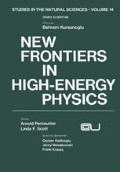Abstract
Last year two of the hottest topics of conversation at this conference were1: 1) the rumor that muon-number violation might have been observed in the μ+→e++γ and 2) the failure of bismuth experiments to detect parity violation at the level predicted by the standard Weinberg-Salam model2. During the intervening time between then and now, several significant theoretical and experimental developments regarding these topics have occurred.
Work supported in part by the U.S. Energy Research and Development Administration under grant number EY-76-C-02-2232B. *000.
Access this chapter
Tax calculation will be finalised at checkout
Purchases are for personal use only
Preview
Unable to display preview. Download preview PDF.
References
TaPei Cheng and C. Bouchiat, Deeper Pathways in High-Energy Physics, edited by Perlmutter and Scott (Plenum Press, New York, 1977) p. 659 and p. 435
S. Weinberg, Phys. Rev. Lett. 19, 1264 (1967); A. Salam in Elementary Particle Physics ed. N. Svartholm (Almquist and Wiksells, Stockholm 1968 ) p. 367.
For a pre-gauge-theory review of these processes, see S. Frankel, in Muon Physics, edited by C. S. Wu and V. W. Hughes (Academic Press, New York, 1975 ), Vol. II, p. 83 and references therein.
P. Depommier et al., Phys. Rev. Lett. 39, 1113 (l977).
H. Povel et al., Phys. Lett. 72B, 83 (1977).
A. Badertscher et al., Phys. Rev. Lett. 39, 1385 (1977).
W. J. Marciano and A. I. Sanda, Phys. Rev. Lett. 38, 1512 (1977); G. Altarelli, L. Baulieu, N. Cabibbo, L. Maiani and R. Petronzio, Nucl. Phys. B125, 285 (1977).
L. L. Lewis et al., Phys. Rev. Lett. 39, 795 (1977); P. Baird et al. ibid 39, 798 (1977).
R. Mohapatra, F. Paige and D. Sidhu, B.N.L. preprint 1977; and R. Mohapatra in his talk at this conference.
C. E. Loving and P. Sandars, Oxford University preprint 1977.
Theoretical background for these effects can be found in: M. A. Bouchiat and C. C. Bouchiat, Phys. Lett. 48B, 111 (l974), Le Journal De Physique 35, 899 (1974); 36, 493 (1975).
G. Feinberg, “Parity Non-Conservation in Atoms”, Columbia University preprint 1977. This paper reviews the status and background of these calculations. It also describes the feasibility of performing similar experiments in other atoms.
W. J. Marciano and A. I. Sanda, “Parity Violation in Atoms Induced by Radiative Corrections” Rockefeller University preprint C00-2232B-142. Submitted by Phys. Rev. D.
S. Parker, H. Anderson and C. Rey, Phys. Rev. 133 B768 (1964).
S. M. Korenchenko et al. Zh. Eksp. Teor. Fiz. 70 3 (1976) [Sov. Phys. JETP 43 1 (1976)].
D. A. Bryman, M. Blecher, K. Gotow and R. J. Powers, Phys. Rev. Lett. 28, 1469 (l972).
A discussion of other muon-number non-conserving processes can be found in Ta-Pei Cheng and Ling-Fong Li, Phys. Rev. D16, 1425 (1977).
The best bounds on the possible decay νμ→νe+γ come from Astrophysics, see M.A.B. Bég, W. J. Marciano and M. Ruderman, to be published in Phys. Rev. D and references therein.
J. D. Bowman, Private communication.
D. Bryman, private communication.
For a review of muon capture which contains many references to the literature, see N. C. Mukhopadhyay, Phys. Reports 30C, 1 (1977).
S. Weinberg and G. Feinberg, Phys. Rev. Lett. 3, 111, 244 ( E) (1959). This paper provides a clear analysis of muon conversion, and formulas which are easily applied to gauge theories.
F. J. Ernst, Phys. Rev. Lett. 5, 478 (1960).
If we discard inelastic processes (which experimentalists would probably not identify as conversions anyway), then the 8 in the donominator of (3.6) becomes ~10 and our numerical predictions are reduced by about a factor of.8 C.f. ref. 22.
T.-P. Cheng and L.-F. Li, Phys. Rev. Lett. 38, 381 (1977); S. M. Bilenky, S. T. Petcov, and B. Pontecorvo, Phys. Lett. 67B, 309 (1977).
J. D. Bjorken, K. Lane, and S. Weinberg, Phys. Rev. D16, 1474 (1977).
B. W. Lee, S. Pakvasa, R. E. Shrock and H. Sugawara, Phys. Rev. Lett. 38, 937, 1230 (E) (1977); B. W. Lee and R. Shrock, Phys. Rev. D16, 1444 (1977).
F. Wilczek and A. Zee, Phys. Rev. Lett. 38, 531 (1977).
S. B. Treiman, F. Wilczek and A. Zee, Phys. Rev. D16, 152 (1977).
S. M. Barr and S. Wandzura, Phys. Rev. D16, 707 (1977).
W. J. Marciano and A. I. Sanda, Phys. Lett. 67B, 303 (1977).
M. A. B. Bég and A. Sirlin, Phys. Rev. Lett. 38, 1113 (1977).
In a model proposed by J. D. Bjorken and S. Weinberg, Phys. Rev. Lett. 38, 622 (1977) muon-number violations result from the Higgs sector of the theory; therefore the magnitude of ReN depends on the quark-Higgs couplings which are essentially free parameters.
The details of these calculations can be found in the appendix of ref. 13.
I have used the value sin2θW≃.24 throughout this talk. C. f. M. Holder et al. “Study of Inclusive Neutral Current Interactions of Neutrinos and Antineutrinos”, CERN preprint 1977.
The box diagrams involving two W exchanges contribute about 4% while the diagrams with two Z’s are almost insignificant for this model.
Q. Shafi and Ch. Wetterich, Phys. Lett. 69B 464 (1977). This paper presents a nice procedure for extracting this leading logarithm.
M.A.B. Bég, R. Budny, R. Mohapatra and A. Sirlin, Phys. Rev. Lett. 38, 1252 (1977).
Author information
Authors and Affiliations
Editor information
Editors and Affiliations
Rights and permissions
Copyright information
© 1978 Plenum Press, New York
About this chapter
Cite this chapter
Marciano, W.J. (1978). Status of Muon-Number Conservation and Comments on Parity Violation in Atoms. In: Perlmutter, A., Scott, L.F. (eds) New Frontiers in High-Energy Physics. Studies in the Natural Sciences, vol 14. Springer, Boston, MA. https://doi.org/10.1007/978-1-4613-2865-0_14
Download citation
DOI: https://doi.org/10.1007/978-1-4613-2865-0_14
Publisher Name: Springer, Boston, MA
Print ISBN: 978-1-4613-2867-4
Online ISBN: 978-1-4613-2865-0
eBook Packages: Springer Book Archive

